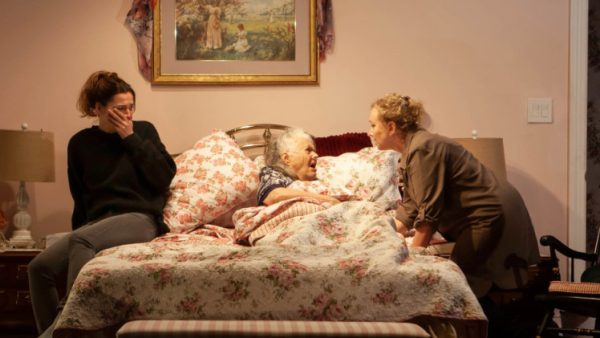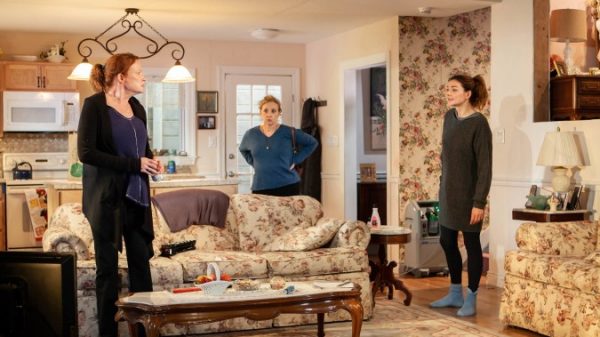Review: In “Peace for Mary Frances,” A Terrifying Looking-Glass of Loss
Heather Burns, Lois Smith and J. Smith-Cameron in “Peace for Mary Frances,” a new show by The New Group. (COURTESY OF MONIQUE CARBONI)
June 6, 2018
For better or for worse, there are times when theater comes dangerously close to reality, when imitation may brush too close for comfort and break the skin. Realism comes at a price.
Audiences of “Peace for Mary Frances,” a new play by Lily Thorne presented by The New Group and housed at The Pershing Square Signature Center, may in this way confront the crushing burden of a play that skates alarmingly close to real life, that shrugs off the protection of theatricality and trades melodrama for bare, shattering salience.
At the heart of this play lies a fear so central to the human experience, to witness it plainly is painstaking and exhausting. It’s not the fear of death, but the fear of waiting to die — of being trapped in a tired, spent body, unable to leave, held on this earth either by an anatomy stubbornly unwilling to quit or by some remaining, binding strings of conflict.
In Thorne’s debut play, directed by Lila Neugebauer (“The Wolves”), Mary Frances is 90 years old and ready to die. Over nearly three hours, we join Mary Frances in her small, Hartford home as her family, rife with anger, conflict and sibling resentment, battle to reckon with the slow death of their mother. We watch as she gradually descends into the darkness and loneliness that comes in expectation of death — from exhaustion, to hospice care, to catatonia — enveloped not by the gift of peace, but by the sounds of a broken, unhappy family unwilling or unable to get out of their own way to guide their mother from this life.
Perhaps what is most striking about this play is that Thorne and Neugebauer, aided by a stunningly lifelike, almost claustrophobic set design by veteran Dane Laffrey (“Once on This Island,” “Spring Awakening”), have endeavored to create a theatrical event that manifests so clearly the sensory and practical experiences of a dying woman’s home.
An oxygen tank, tucked into a corner of Mary Frances’ well-kept home, wheezes and huffs throughout the entire show, its high-pitched, dog-whistle hiss clawing at the audience’s ears. There are times during the play when the house sits in complete silence — in the dead air of a still theater, seconds quickly turn to labored minutes — as Mary Frances lays in her bed, struggling to breath. And, with the exception of many heated sibling and family arguments, each fueled by anxieties over money, medicine, in-home care and life-long resentment, the play is incredibly undramatic; it is a slow, painful crawl to the end with every second felt in a masterful endeavor by Thorne to write empty space.
As Mary Frances, Lois Smith (“Lady Bird”) gives what could be a career-defining theatrical performance, if not for the small scale of this intimate, off-Broadway production. To this role she brings a tenderness, a softness and a wrenching honesty that, somehow, she is able to deliver mostly confined to a bed, covered under blankets for most of the show. J. Smith-Cameron (“Rectify”) and Johanna Day (“Sweat”) lead a well-casted, compatible ensemble of family members behind her.
Boiled down, “Peace For Mary Frances” is voyeurism of the most solemnly perverse kind, and that comes at a price.
For those in the audience who may have recently dealt with the wearying lost of a loved one, I can’t imagine how they would make it through this play. (There were murmurs in my row that a group sitting in front of us left during intermission, unable to deal with the emotional burden of this production, to relive so plainly the creeping performance of a family member’s death.)
And the play is long, certainly overlong.
Ruled by Thorne’s dedication to some variety of vérité, the show suffers from a lack of plot. Other than an exhaustively repetitious cycle of screaming and fighting (and Mary France’s decline into death, of course), nothing really does happen in this show, much to the detriment of my (and everyone else’s in the audience) emotional stamina as Thorne furnishes an essential question of old age and dying: is it better to die peacefully alone or surrounded by a broken, hostile family?
While the show’s lack of movement may in any other circumstance be soundly problematic, I hesitate to levy judgement. Thematically, one wonders what in fact Thorne is trying to show us, what here might be purposefully tiresome, what experiment in observation she may be trying to perform and what the installation of an ugly, terrifying looking-glass of death and family might exercise.











